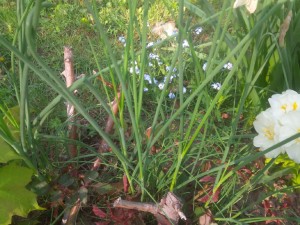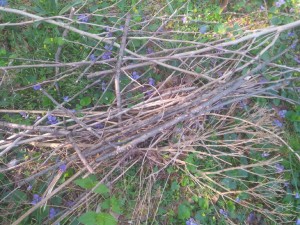
In my neighborhood we enjoyed winter right through April, followed by ten minutes of spring. Now we are in the process of jumping headfirst into summer. The last of the daffodils, having survived late snow, cold spring winds and all kinds of insults, hang their heads, defeated by a sudden blast of hot sticky air.
The first thing to do in this changeable season is deadhead those daffodils. They will appreciate it, because it saves them the trouble of setting seed and lets them get on with the business of storing energy for next year’s blooms. They will also look better. Few people have time any more to hobble their daffodils by braiding their long leaves, or worse, yet, chopping those leaves off too soon. However, if you are one of those people, restrain yourself for the good of the plants. The foliage has to ripen and begin to yellow before the daffodils’ spring renewal cycle ends.
Divide snowdrops, grape hyacinths and other small spring bloomers now, before hot weather drives them to hide away until next year. Dig deeply and gently, divide the clumps with your hands and install the new divisions under trees, in the fronts of borders or anywhere else that might have been lacking in early spring interest in March.
Marking the locations of “spring ephemerals”, like snowdrops, is always a problem. For years I did it with small golf tees, but even these tend to get lost in the weeding and maintenance routine. Not long ago I read about someone who marks locations with handfuls of ordinary sand. This does not harm plants or soil and may be more viable than golf tees.
Since winter was so brutal and good spring weather so scarce this year, I am still doing clean-up. Every time I think I have picked up all the downed sticks, I find a seven foot branch behind the garage that needs to be cut down to size, bundled and sent to the curb. It is frustrating when all I really want to do is go to the garden center and bankrupt myself buying new plants.
Still, gardening should be as much about discipline as delight and disbursements, so keep cleaning up. I could spend days just digging onion grass out of my beds. This year it has outpaced chickweed as public enemy number one in my garden. It is my own fault for taking such pains with my soil that I have created paradise for onion grass. What a pity that the deer refuse to eat it.
If you don’t have onion grass or other noxious spring weeds to keep you busy, and you have already divided—or declined to divide—your spring ephemerals, consider cost-effective ways of filling landscape or container gardening holes. Hostas breed like rabbits and are easiest to divide when they are just emerging in the spring. I use the Japanese garden knife to saw through the tough hosta roots, but an old kitchen knife will do just as well.

Daylilies need dividing about every three years, which will come as a surprise to the many daylily owners who have never divided their clumps. If you do this right now, you will still have daylily bloom this year, not to mention plants that are more robust in the years to come. The only real exception to this every-three-year division rule is the common tawny daylily, sometimes known as “ditch lily” for its tendency to grow prolifically in waste spaces. Tawny daylilies require absolutely nothing except admiration for their tenacity. Do not waste precious garden time digging and dividing them unless, you are running out of space or they have invaded your house.
The hard winter took a toll on my hydrangeas too. Now that the shrubs have budded and are beginning to leaf out, the dead branches are very obvious, resembling bleached bones jutting up or outward from the plants. Cutting them off will make the hydrangeas look much more presentable and will not affect this year’s flower production. When you ply your clippers, just remember not to cut off any stem that has a green bud.
Above all, don’t get too anxious about the fact that there are at least 1,000 things to do in the garden right now and approximately one hour each week when you have time to do them. Exuberance is a spring phenomenon for plants, just as crowded schedules are spring phenomena for humans. The plants will slow down by and by, and eventually you will find a few hours that you do not owe to your children, spouse, employer, doctor, dentist or volunteer obligations. For at least a short time, you and the garden will be in sync.
I try to remember that as I lean in over the clumps of onion grass.
